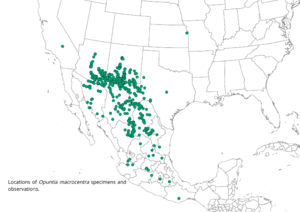Long-spined purplish prickly pear facts for kids
Quick facts for kids Long-spined purplish prickly pear |
|
|---|---|
 |
|
| Scientific classification | |
| Genus: |
Opuntia
|
| Species: |
macrocentra
|
The purple prickly pear (Opuntia macrocentra) is a cool cactus found in the Southwestern United States and parts of Mexico. It's part of the prickly pear family. What makes it special is its amazing purple color! People also call it the black-spined prickly pear or redeye prickly pear.
This cactus grows like a bushy plant with flat, joined parts called pads. It has big, bright yellow and red flowers. Its dark red fruits are safe to eat.
Contents
Where Does It Grow?
You can find the purple prickly pear naturally in places like Arizona, New Mexico, and parts of Texas and Mexico.
This cactus grows slowly and lives for many years. It can be found in different types of soil and habitats. It often grows in sandy desert areas, rocky hills, or grassy valleys below 5,000 feet (about 1,500 meters).
What Does It Look Like?
The purple prickly pear is a bushy plant that usually grows about 1 to 2 feet (30 to 60 cm) tall. Sometimes, it can even reach 3 feet (1 meter) in height. Its stem can be blue-gray, blue-green, or purplish.
The purple color is strongest at the edges of the pads or around the small bumps called areoles. This purple color comes from a special pigment. It becomes even brighter when the plant is stressed by dry weather or cold temperatures.
Cactus Pads
The cactus has smooth, oval-shaped pads that are connected to each other. Each pad is usually wider than it is long, about 4 to 8 inches (10 to 20 cm) wide and long.
The areoles are dark spots on the pads. These are like tiny branches where spines and small, barbed bristles called glochids grow. They are arranged in diagonal rows on the middle of the pad.
Spines grow only on the top half or the upper edge of the pad. Each areole can have one to three main spines. The longest spine can be 2 to 4 inches (5 to 10 cm) long. The biggest spine usually points straight up. Sometimes, the spines have white or yellow tips. Flowers grow on the upper edge of the pads.
Beautiful Flowers
The flowers of the purple prickly pear are large and strong with bright colors. They have yellow petals with red parts closer to the center. This creates a bright red middle.
The parts inside the flower that help it reproduce are pale yellow or cream-colored. This cactus blooms in the spring, usually from March to June. The flowers open in the middle of the morning and close at night. They do not open again.
Edible Fruit
If a flower is pollinated, the cactus will grow small, oval-shaped fruits. When ripe, these fruits can be bright red or dull purple.
The fruit is juicy and about half the size of the flower. It is usually 1 to 1.5 inches (2.5 to 4.0 cm) long. Each fruit has about 12 to 16 areoles. The skin of the fruit is purple, and the inside pulp and juice are light purple or clear. The fruit contains flat, tan seeds. These seeds are very small, less than 0.16 inches (4 mm) long, with a notch on one side.
How People Use It
The purple prickly pear is grown as an ornamental plant because of its striking stem and flower colors. It's great for gardens that don't need much water, called drought-tolerant gardens. It's also used in native plant gardens and as a potted plant.
Like many other cacti in the Opuntia family, the fruit of the purple prickly pear is safe to eat.
In some areas, collecting this cactus or its fruit is limited. This helps protect the plant and keep it from disappearing.
Gallery






